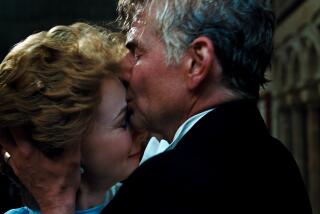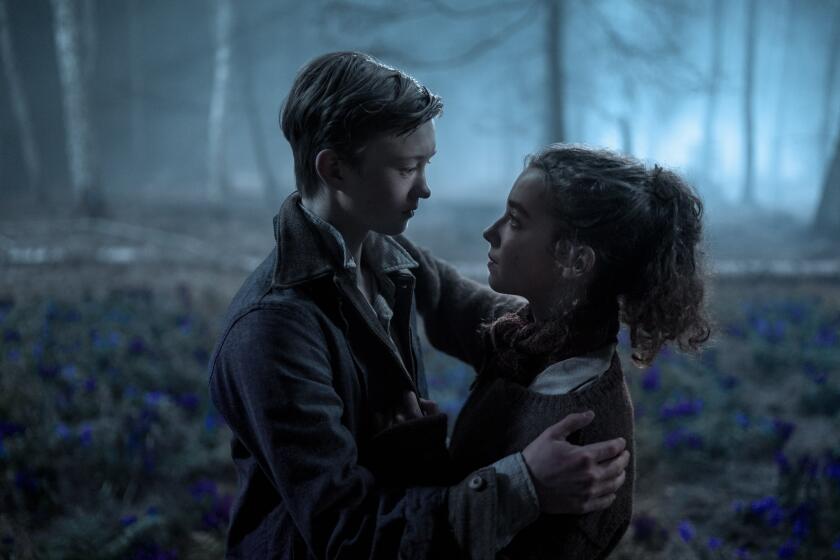MOVIE REVIEW : Bewitching, Live Score Joins Silent ‘Dr. Caligari’ at Nuart
“The Cabinet of Dr. Caligari” (1919) has had the good fortune to receive what every great silent film deserves: a score worthy of it. When the German classic is screened Thursday and Friday at the Nuart, it will be presented with Richard Marriott’s splendid new score performed live by the Club Foot Orchestra of San Francisco.
Don’t be put off by the name of this 10-member ensemble, dedicated to the eclectic in music, which conjures up the unhappy memory of silent films desecrated on TV as “Fractured Flickers.” The Club Foot (which takes its name from a defunct nightclub), of which Marriott is a member, may be witty, but it’s serious. (The orchestra will also be accompanying the film Saturday at the Ken Theater in San Diego and Sunday at the Victoria Street Theater, Santa Barbara.)
Few films have been as influential as “The Cabinet of Dr. Caligari.” It ushered in the golden age of the German silent cinema, which arrived in the wake of World War I along with the dizzying postwar inflation which in turn paved the way for fascism. With its boldly innovative Expressionist style, the film projected powerfully--and prophetically--a vision of society as an insane asylum under the rule of a clever and evil madman.
The world of “Caligari” is that of a nightmare in which highly stylized settings--designed by the Expressionist artists Hermann Warm, Walter Rohrig and Walter Reimann--are a jumble of distorted angles and forced perspectives. Eventually, we realize that we are seeing the world through the eyes of the film’s narrator, a distraught young man named Francis (Friedrich Feher). He tells a horrifying tale of a magician who calls himself Dr. Caligari (Werner Krauss--beetle-browed, top-hatted, his eyes distorted by circle glasses with pop bottle bottom-thick lenses).
Caligari has arrived in the fictional German town of Holstenwall with a carnival, and his act is to present Cesare the Sonambulist (a cadaverous-looking Conrad Veidt) who upon being wakened in his upright coffin--the “cabinet” of the film’s title--makes predictions out of questions from the audience. Clearly, Cesare is in the weird doctor’s thrall; meanwhile, Holstenwall is struck by a series of murders.
As the disturbing implications of the film spread like a plague, an eerie and mournful waltz motif emerges in Marriott’s score. With its xylophone trills and trumpet flourishes, it allows us to see the people in cinematographer Karl Freund’s flow of increasingly feverish images as engaged in a kind of relentless dance of death. This waltz is juxtaposed with jangling, jerky passages reminiscent of Kurt Weill’s music for “The Three-Penny Opera”; at other times the score turns into a painful, crashing wail.
Like Georges Delerue’s new score for the French silent “Casanova,” Marriott’s music manages to sound entirely appropriate without seeming in any way quaint or dated; one could wish that Fritz Lang’s restored “Metropolis” had fared as well, instead of having been inflicted with Giorgio Moroder’s insistent electronic music.
Lang, incidentally, had been assigned by producer Erich Pommer to direct “The Cabinet of Dr. Caligari” but couldn’t complete his ambitious two-part adventure “The Spiders” in time to do it. The task fell to Robert Wiene, whose subsequent films proved disappointing. However, Lang is credited with providing the framing story for the film, which adds a profoundly disturbing dimension to Carl Mayer and Hans Janowitz’s script. Indeed, it is possible to trace the influence of “The Cabinet of Dr. Caligari” throughout Lang’s work with its preoccupation with powerful figures of evil, whether underworld kingpins or Adolf Hitler himself.
More to Read
Only good movies
Get the Indie Focus newsletter, Mark Olsen's weekly guide to the world of cinema.
You may occasionally receive promotional content from the Los Angeles Times.










